why we unit test in laravel9
why we use assertTrue in unit test in laravel9
why we use assertTrue in unit test in laravel9 with example
how my foreach loop working using unit test in laravel9 with example
how assert true unit testing in laravel 9 is helpful to check coding
how assert true unit testing in laravel 9 is helpful to check coding with example
how assert true unit testing in laravel 9 is helpful to build logic with example
how to test flow foreach loop working in laravel9 with example
Interaction-based Unit Testing in laravel9 with example
state-based Unit Testing in laravel9 with example
how unit test fun working right in laravel 9 with example
how unit test class working right in laravel 9 with example
how assert.istrue works in laravel9 with example
what are the different type of assertions in laravel9 with example
why we unit test in laravel9
Unit testing is a process in software development where individual units or components of code are tested in isolation from the rest of the application to ensure they are working as intended. In Laravel, unit tests are a crucial part of the development process as they help to identify bugs early in the development cycle, making it easier to fix them before they cause bigger problems in the future.
Unit testing also helps to improve the overall quality of the code by ensuring that changes to the code do not break existing functionality. This helps to maintain the stability and reliability of the application, and reduces the likelihood of bugs and other issues affecting the end user.
In Laravel 9, unit testing is made easier and more efficient through the use of the built-in testing tools and frameworks. For example, Laravel provides an easy-to-use testing API that makes it simple to write and run tests, and it also provides various assertions and helpers to make testing easier.
Overall, unit testing in Laravel 9 helps to improve the quality and reliability of the code, reduce the time and effort required to fix bugs, and increase confidence in the application.
why we use assertTrue in unit test in laravel9
The assertTrue method is commonly used in unit tests to check if a given condition is true. It is a basic assertion that can be used to verify that the expected outcome has been achieved. For example, you might use assertTrue to check that a variable has the expected value, that a method returns the expected result, or that a certain condition is met.
In Laravel 9, the assertTrue method is part of the PHPUnit testing framework that is included with the Laravel framework. PHPUnit is a powerful testing framework that provides a large number of assertions and helpers to make it easier to write and run tests. The assertTrue method is just one of many assertions provided by PHPUnit, and it can be used in combination with other assertions to create more complex tests.
By using assertTrue in your unit tests, you can ensure that the code is functioning as expected and that the results are what you expect. This helps to catch any bugs or issues early in the development cycle, making it easier to fix them before they cause bigger problems in the future. Additionally, using assertTrue and other assertions can help to improve the overall quality and reliability of your code, by verifying that it behaves as expected under different conditions.
<?php
namespace Tests\Unit;
use Tests\TestCase;
class ExampleTest extends TestCase
{
public function testAddition()
{
$result = 2 + 2;
$this->assertTrue($result == 4, 'The result should be 4');
}
}
In this example, the testAddition method performs the addition of 2 + 2 and stores the result in the $result variable. Then, it uses the assertTrue method to check that the result is equal to 4. If the result is not equal to 4, the test will fail and the message "The result should be 4" will be displayed.
By using the assertTrue method in this way, you can verify that the code is functioning as expected and that the result of the addition is correct. This helps to catch any bugs or issues early in the development cycle, making it easier to fix them before they cause bigger problems in the future.
how my foreach loop working using unit test in laravel9 with example
Here's an example of how you might use a unit test to verify the behavior of a foreach loop in Laravel 9:
Suppose you have a function that loops over an array of numbers and adds them together. Here's an example test for this function:
<?php
namespace Tests\Unit;
use Tests\TestCase;
class ExampleTest extends TestCase
{
public function testArraySum()
{
$numbers = [1, 2, 3, 4, 5];
$sum = 0;
foreach ($numbers as $number) {
$sum += $number;
}
$this->assertTrue($sum == 15, 'The sum should be 15');
}
}
In this example, the testArraySum method defines an array of numbers and initializes a variable $sum to store the sum of the numbers. Then, it uses a foreach loop to iterate over the array and add each number to the sum. Finally, it uses the assertTrue method to check that the sum is equal to 15. If the sum is not equal to 15, the test will fail and the message "The sum should be 15" will be displayed.
By using a unit test in this way, you can verify that the foreach loop is functioning as expected and that the sum of the numbers is correct. This helps to catch any bugs or issues early in the development cycle, making it easier to fix them before they cause bigger problems in the future.
how assert true unit testing in laravel 9 is helpful to check coding
The assertTrue method in Laravel 9 unit testing is helpful in checking the code because it allows you to verify that the code is producing the expected results. By writing tests that use assertTrue and other assertions, you can validate that the code is functioning as expected and that it produces the correct output for a given set of inputs.
how assert true unit testing in laravel 9 is helpful to check coding with example
<?php
namespace Tests\Unit;
use Tests\TestCase;
class ExampleTest extends TestCase
{
public function testRectangleArea()
{
$width = 10;
$height = 5;
$area = $width * $height;
$this->assertTrue($area == 50, 'The area should be 50');
}
}
how assert true unit testing in laravel 9 is helpful to build logic with example
assertTrue unit testing in Laravel 9 is helpful in building logic by providing a way to verify that the code is functioning as expected. By writing tests that use assertTrue and other assertions, you can validate that the code is producing the correct output for a given set of inputs. This helps you to build logic that is correct and reliable.
Here's an example of how assertTrue unit testing can be helpful in building logic in Laravel 9:
Suppose you have a function that checks if a number is odd or even. Here's an example test for this function:
<?php
namespace Tests\Unit;
use Tests\TestCase;
class ExampleTest extends TestCase
{
public function testIsOdd()
{
$number = 7;
$isOdd = $number % 2 != 0;
$this->assertTrue($isOdd, 'The number should be odd');
}
}
In this example, the testIsOdd method checks if the number 7 is odd. It stores the result in the $isOdd variable. Finally, it uses the assertTrue method to check that the $isOdd variable is true. If the $isOdd variable is not true, the test will fail and the message "The number should be odd" will be displayed.
By using this unit test, you can verify that the code is checking if a number is odd correctly. If there are any bugs or issues with the code, the test will fail and you'll know that there is a problem that needs to be fixed.
By using assertTrue and other assertions in unit testing, you can build logic that is correct and reliable. This is particularly important when working on large projects or when making changes to existing code, as it helps to catch any issues early in the development process before they become bigger problems.
how to test flow foreach loop working in laravel9 with example
To test a foreach loop in Laravel 9 using unit tests, you can write a test case that loops over an array and verifies that the code inside the foreach loop is working correctly.
Here's an example of how you might test a foreach loop in Laravel 9:
<?php
namespace Tests\Unit;
use Tests\TestCase;
class ExampleTest extends TestCase
{
public function testForeachLoop()
{
$numbers = [1, 2, 3, 4, 5];
$sum = 0;
foreach ($numbers as $number) {
$sum += $number;
}
$this->assertTrue($sum == 15, 'The sum should be 15');
}
}
In this example, the testForeachLoop method loops over an array of numbers [1, 2, 3, 4, 5] and adds each number to a $sum variable. After the foreach loop has completed, it uses the assertTrue method to check that the $sum variable is equal to 15. If the $sum variable is not equal to 15, the test will fail and the message "The sum should be 15" will be displayed.
By using this unit test, you can verify that the foreach loop is functioning correctly and adding up the numbers in the array as expected. If there are any bugs or issues with the code, the test will fail and you'll know that there is a problem that needs to be fixed.
This is just one example of how you might use unit tests to test a foreach loop in Laravel 9. Depending on the specifics of your code, you may need to write more complex tests that verify the behavior of the loop under different conditions.
Interaction-based Unit Testing in laravel9 with example
Interaction-based unit testing in Laravel 9 involves testing the interactions between objects in your code. It helps to verify that the objects are correctly communicating with each other and that the desired behavior is being produced.
Here's an example of interaction-based unit testing in Laravel 9:
Suppose you have a class that represents a shopping cart. The shopping cart class has a method addProduct that adds a product to the cart and a method getTotal that returns the total cost of the products in the cart. You can write an interaction-based test to verify that the shopping cart class is working correctly:
<?php
namespace Tests\Unit;
use App\ShoppingCart;
use App\Product;
use Tests\TestCase;
class ExampleTest extends TestCase
{
public function testShoppingCart()
{
$shoppingCart = new ShoppingCart;
$product1 = new Product(1, 'Product 1', 10);
$product2 = new Product(2, 'Product 2', 20);
$shoppingCart->addProduct($product1);
$shoppingCart->addProduct($product2);
$this->assertTrue($shoppingCart->getTotal() == 30, 'The total should be 30');
}
}
In this example, the testShoppingCart method creates a new shopping cart and two new products. It then adds the two products to the shopping cart using the addProduct method. Finally, it uses the assertTrue method to check that the getTotal method returns 30, which is the expected total cost of the two products. If the getTotal method does not return 30, the test will fail and the message "The total should be 30" will be displayed.
By using this interaction-based unit test, you can verify that the shopping cart class is working correctly and that the addProduct and getTotal methods are interacting with each other as expected. If there are any bugs or issues with the code, the test will fail and you'll know that there is a problem that needs to be fixed.
state-based Unit Testing in laravel9 with example
State-based unit testing in Laravel 9 involves testing the state of an object after it has undergone some changes. It helps to verify that the object has the expected state after a certain operation has been performed on it.
Here's an example of state-based unit testing in Laravel 9:
Suppose you have a class that represents a user. The user class has a method addPoints that adds points to the user's total points and a method getPoints that returns the user's current total points. You can write a state-based test to verify that the user class is working correctly:
<?php
namespace Tests\Unit;
use App\User;
use Tests\TestCase;
class ExampleTest extends TestCase
{
public function testUserPoints()
{
$user = new User;
$user->addPoints(10);
$user->addPoints(20);
$this->assertTrue($user->getPoints() == 30, 'The total points should be 30');
}
}
In this example, the testUserPoints method creates a new user object. It then adds 10 points and 20 points to the user using the addPoints method. Finally, it uses the assertTrue method to check that the getPoints method returns 30, which is the expected total points for the user. If the getPoints method does not return 30, the test will fail and the message "The total points should be 30" will be displayed.
By using this state-based unit test, you can verify that the user class is working correctly and that the addPoints and getPoints methods are updating the user's state as expected. If there are any bugs or issues with the code, the test will fail and you'll know that there is a problem that needs to be fixed.
how unit test fun working right in laravel 9 with example
Unit testing is an essential part of software development that helps to ensure that your code is working correctly and that changes to the code do not introduce new bugs. In Laravel 9, you can write unit tests using the built-in testing framework.
Here's an example of how to write a unit test in Laravel 9:
Suppose you have a function add that takes two parameters and returns the sum of the two numbers. You can write a unit test to verify that the add function is working correctly:
<?php
namespace Tests\Unit;
use Tests\TestCase;
class ExampleTest extends TestCase
{
public function testAddFunction()
{
$result = add(2, 3);
$this->assertTrue($result == 5, 'The result should be 5');
}
}
In this example, the testAddFunction method calls the add function with parameters 2 and 3. It then uses the assertTrue method to check that the result of the function is 5, which is the expected sum of 2 and 3. If the result of the add function is not 5, the test will fail and the message "The result should be 5" will be displayed.
By using this unit test, you can verify that the add function is working correctly. If there are any bugs or issues with the function, the test will fail and you'll know that there is a problem that needs to be fixed. Additionally, if you make changes to the function in the future, you can re-run the unit tests to ensure that the changes did not introduce new bugs.
Note: The add function in the example is a simple example for demonstration purposes only. In a real-world scenario, the function would likely be more complex and would perform more operations. The key idea is that you can write unit tests to verify the behavior of any function or method in your code.
how unit test class working right in laravel 9 with example
Unit testing classes in Laravel 9 involves testing the behavior of objects of the class. You can write unit tests to verify that the class is working correctly and that changes to the class do not introduce new bugs.
Here's an example of how to write a unit test for a class in Laravel 9:
Suppose you have a class Calculator that has methods to perform arithmetic operations. You can write a unit test to verify that the class is working correctly:
<?php
namespace Tests\Unit;
use App\Calculator;
use Tests\TestCase;
class ExampleTest extends TestCase
{
public function testCalculatorAddition()
{
$calculator = new Calculator;
$result = $calculator->add(2, 3);
$this->assertTrue($result == 5, 'The result should be 5');
}
public function testCalculatorSubtraction()
{
$calculator = new Calculator;
$result = $calculator->subtract(5, 3);
$this->assertTrue($result == 2, 'The result should be 2');
}
}
In this example, there are two test methods: testCalculatorAddition and testCalculatorSubtraction. The testCalculatorAddition method creates a new Calculator object and calls the add method with parameters 2 and 3. It then uses the assertTrue method to check that the result of the add method is 5, which is the expected sum of 2 and 3.
The testCalculatorSubtraction method is similar to the testCalculatorAddition method, but it tests the subtract method instead. It creates a new Calculator object, calls the subtract method with parameters 5 and 3, and checks that the result is 2, which is the expected difference between 5 and 3.
By using these unit tests, you can verify that the Calculator class is working correctly and that the add and subtract methods are performing the expected operations. If there are any bugs or issues with the class, the tests will fail and you'll know that there is a problem that needs to be fixed. Additionally, if you make changes to the class in the future, you can re-run the unit tests to ensure that the changes did not introduce new bugs.
how assert.istrue works in laravel9 with example
In Laravel 9, the assertTrue method is a part of the TestCase class and is used in unit tests to verify that a condition is true. The method takes a single argument, which is the condition that you want to test, and it checks whether the condition is true or false. If the condition is true, the test will pass. If the condition is false, the test will fail and an error message will be displayed.
Here's an example of how to use the assertTrue method in a Laravel 9 unit test:
<?php
namespace Tests\Unit;
use Tests\TestCase;
class ExampleTest extends TestCase
{
public function testTrueAssertion()
{
$value = true;
$this->assertTrue($value, 'The value should be true');
}
}
In this example, there is a single test method testTrueAssertion that tests whether a value is true. The value $value is set to true, and then the assertTrue method is called with $value as its argument. If $value is true, the test will pass. If $value is false, the test will fail and an error message of "The value should be true" will be displayed.
You can use the assertTrue method to verify any condition that you want to test. For example, you can use it to verify the results of a function call, to check that a certain property of an object is set to a certain value, or to check that a specific exception is thrown when a method is called.
what are the different type of assertions in laravel9 with example
In Laravel, assertions are used to verify the expected outcome of code. Some common assertions in Laravel are:
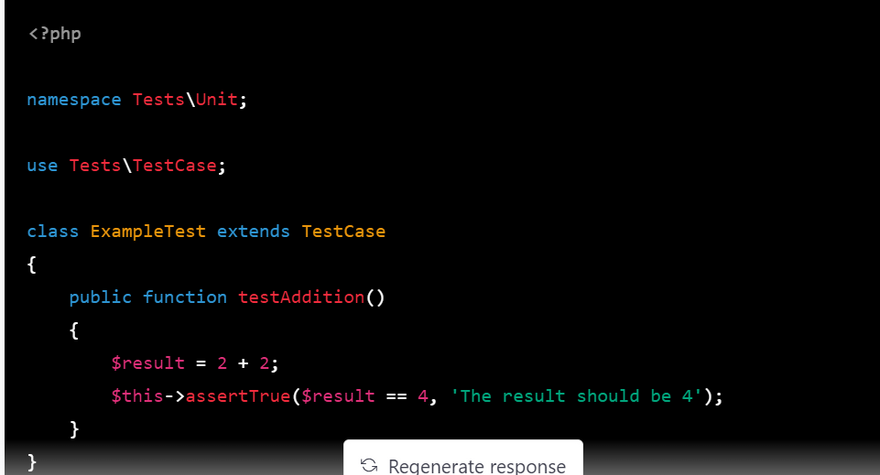
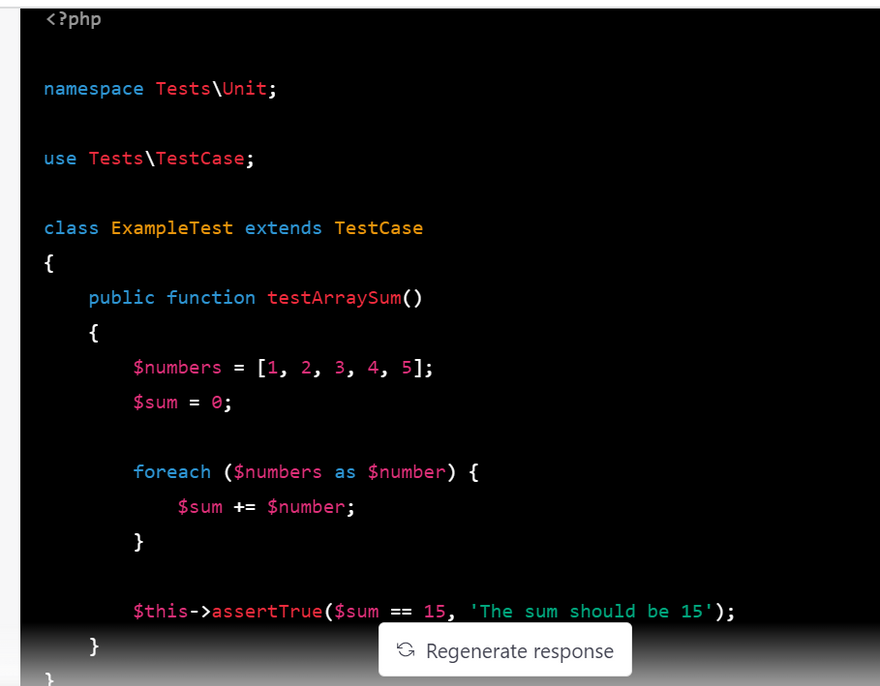
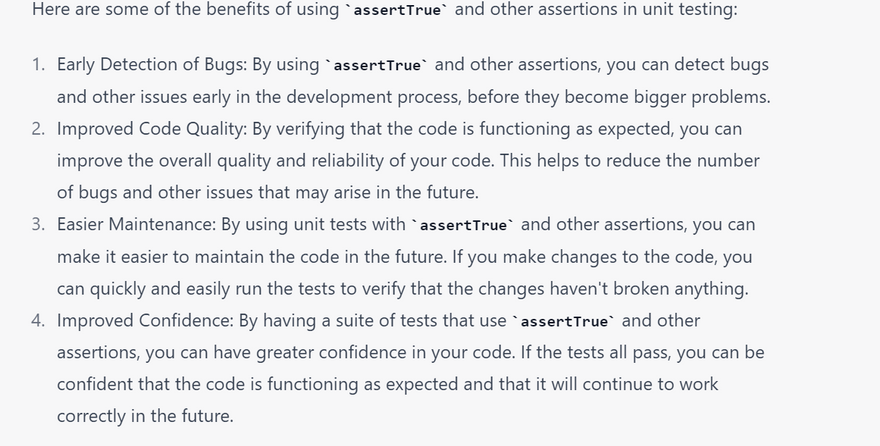
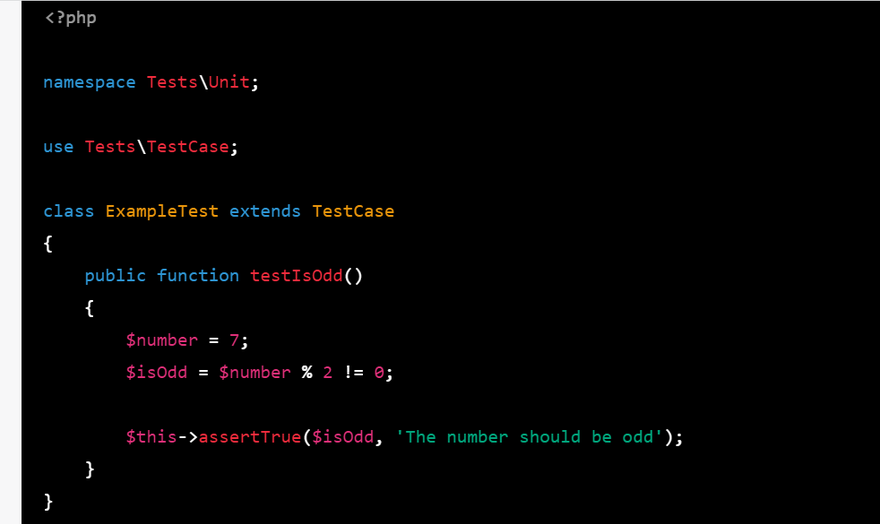
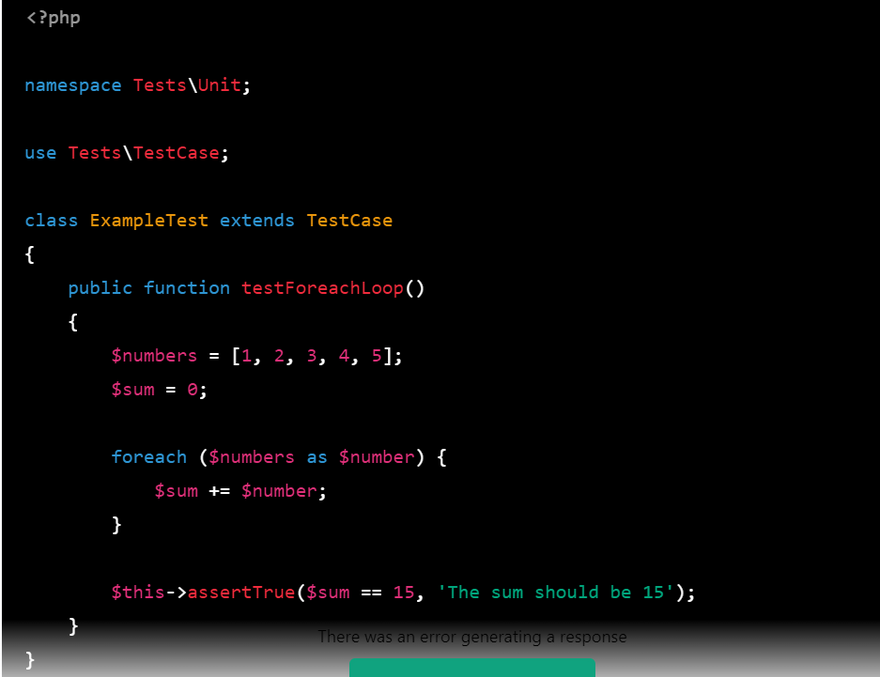
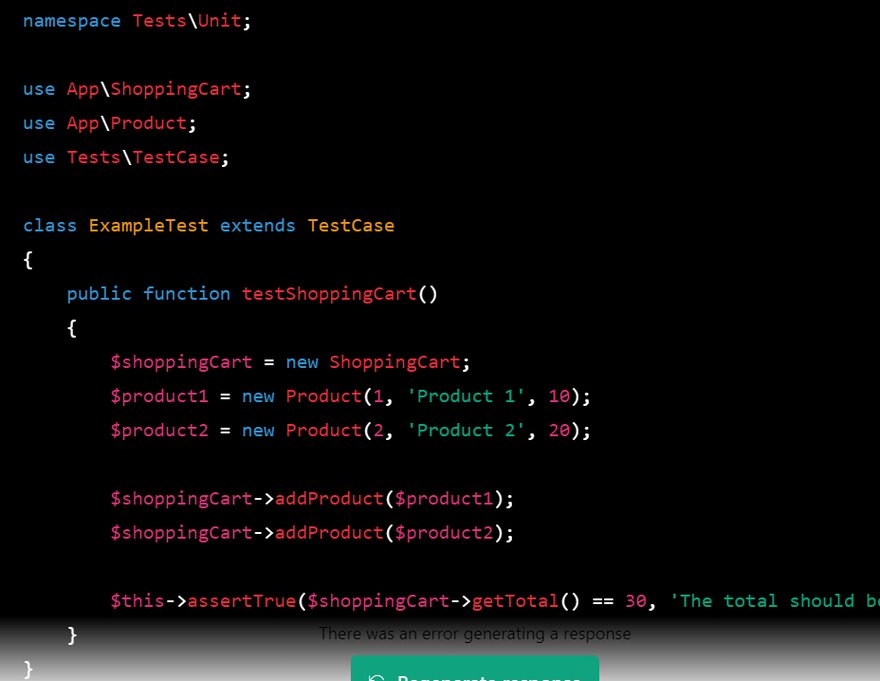
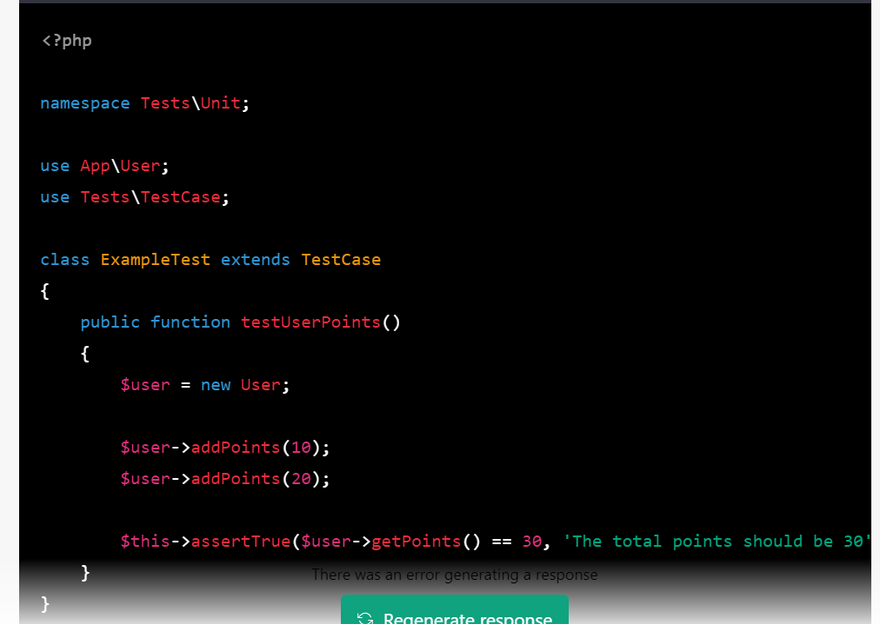
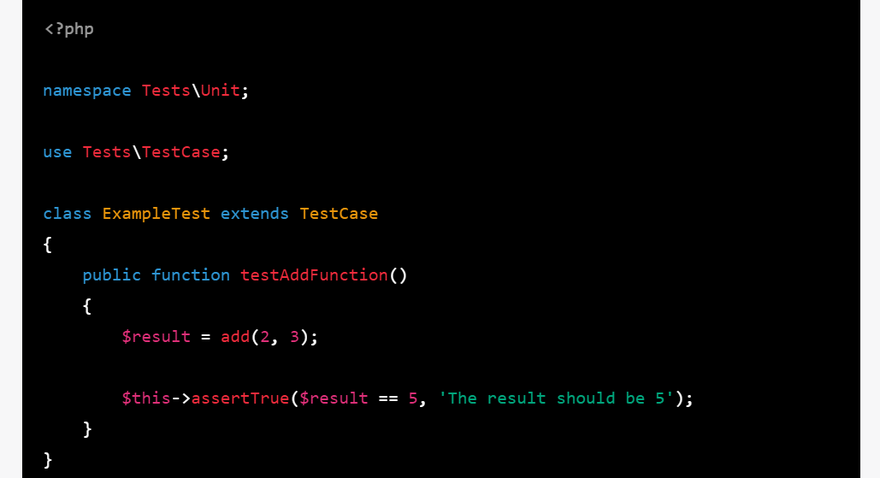
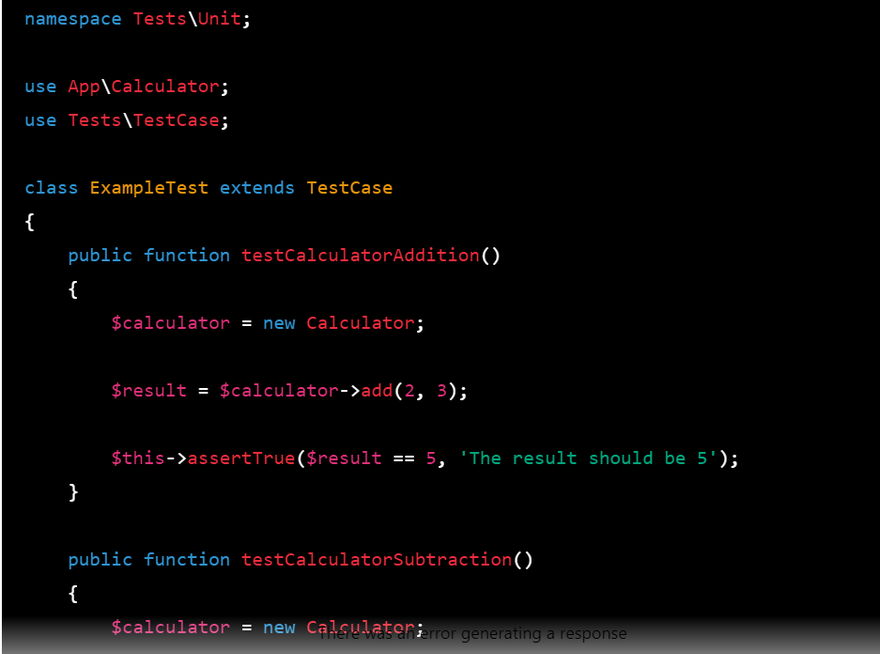
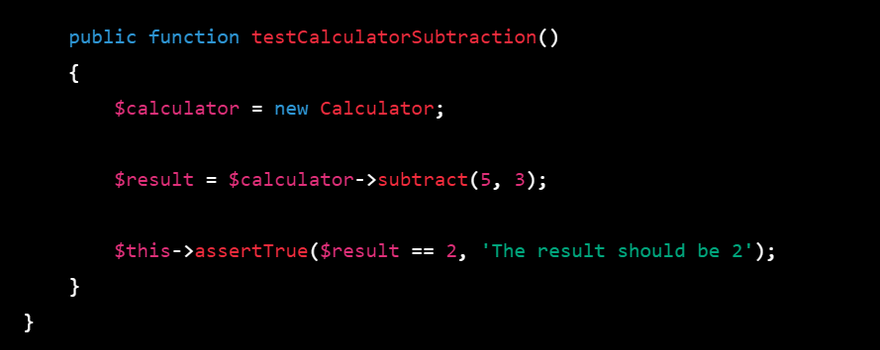
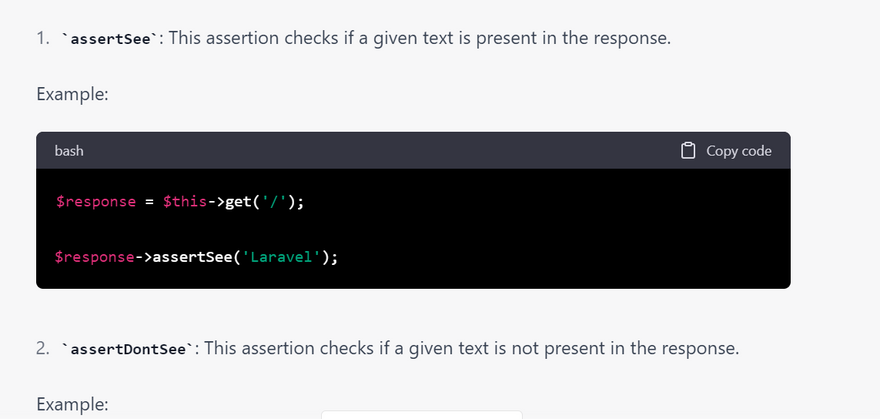

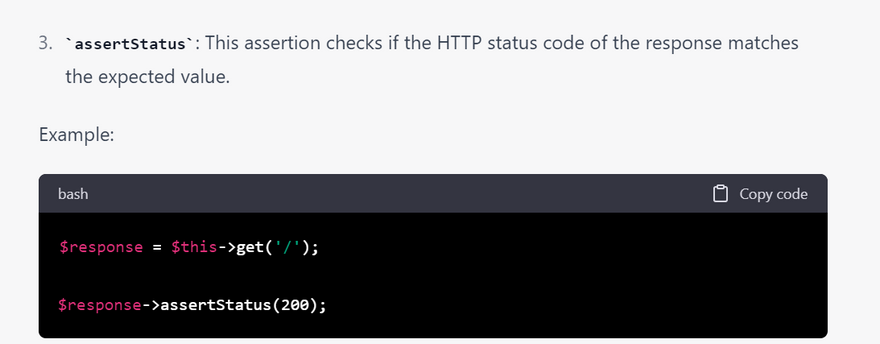
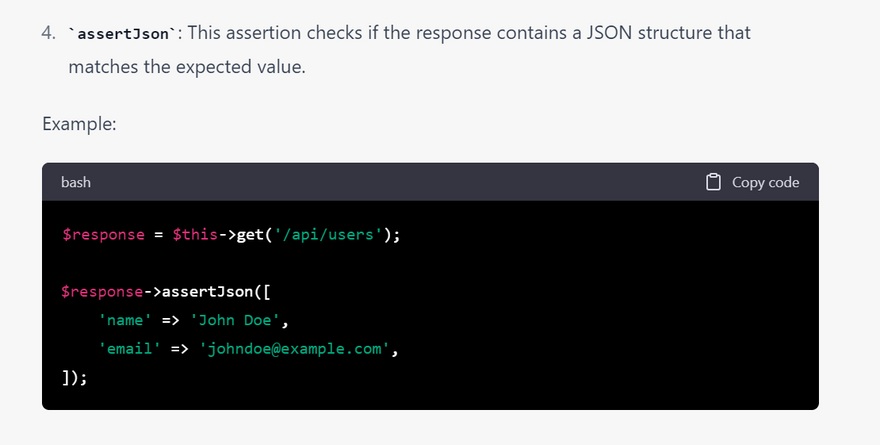
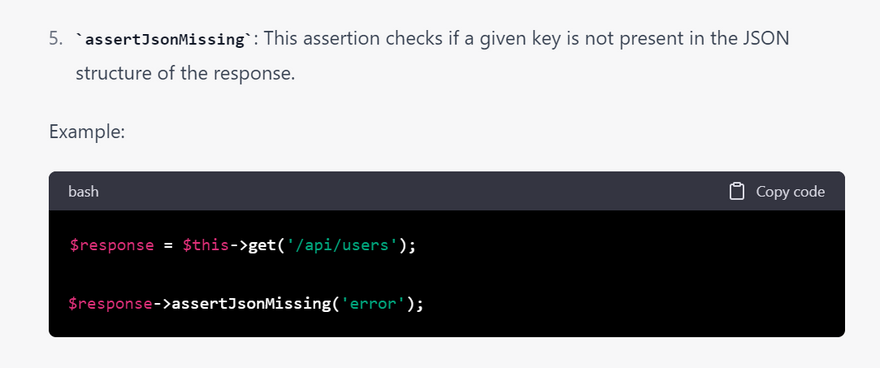
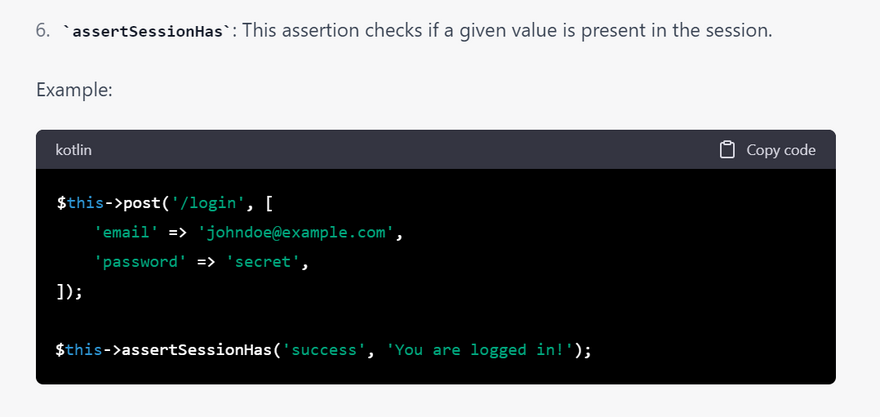

Top comments (0)